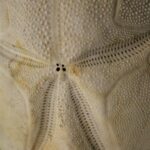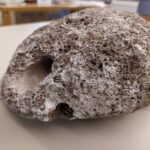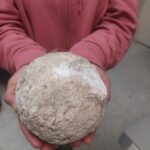ΤHE DEPARTMENT OF HYDROBIOLOGY AND GEOLOGY – PALEONTOLOGY OF THE GNHM ANSWERS TO FREQUENTLY ASKED QUESTIONS
3 FAQs / We answer 3 of your most frequently asked questions.
Do you know what that peculiar “shell” with something like a “starfish” engraved on it, which can be found in our seas, is?
Why do some pebbles have holes? Maybe they are not just pebbles?
And those round stones, could they be dinosaur eggs?
Dr Christina Giamali, Head of the Departments of Hydrobiology and Geology – Paleontology, answers 3 frequently asked questions by younger and older visitors of the Museum.
You can always share with us the questions that arise from observing geological formations or organisms. It is your curiosity that drives us to improve, learn, and share our knowledge with you!
1. (Photo 1) A peculiar shell with an engraved starfish on it? Or a sand dollar?
This peculiar shell that you often ask if it’s the shell of a small sea turtle is actually the shell (test) of an urchin that has lost its spines. But not the common sea urchin we see on the rocks at the beach in summer.
It’s the “sand dollar” scientifically known as Brissus unicolor. Its spines are smaller and finer, ranging from grey to brown. When alive, it buries itself in the sandy seabed, making it difficult to observe. When it dies, it loses its spines and internal organs, leaving behind nothing but its shell. The “starfish-like” shape on its shell is the madreporite, which is part of the water vascular system of echinoderms. Essentially, it’s a series of holes connected to the water vascular system of urchins. This system regulated respiration, food intake, and movement.
2. (Photo 2) These pebbles have peculiar patterns and holes. Who carved them?
You have probably noticed that some pebbles on the beach have smaller or larger holes in them giving them a unique shape, and you might wonder whether they are natural or man-made.
These holes are usually created by a category of sponges called demosponges. Demosponges erode the substrate they live on via both chemical and mechanical processes.
Larger holes can be bored into pebbles and rocks by other organisms, like date mussels (Bivalvia, Mollusca). These organisms bore holes by means of mechanical action and glandular secretions. In both cases, these pebbles are evidence of organism activity, thus serving as trace fossils.
3. (Photo 3) Dinosaur eggs or Pseudofossils?
Some geological structures may confuse us as they resemble fossils. One such example is concretions, which are discrete masses of inorganic elements that may look like fossilized eggs or bones. They usually form when inorganic elements (e.g., silicon or calcium) start to deposit around a nucleus (e.g., a pebble or shell). This process occurs during the formation of sedimentary rocks surrounding them. Concretions typically have a spherical, ovoid, or lenticular shape, which is why they are easily confused with organic remains.
Newsletter
Subscribe to our email newsletter to receive updates on the latest news.
Read the Privacy Policy.




